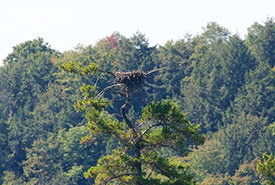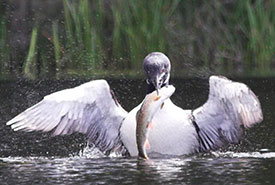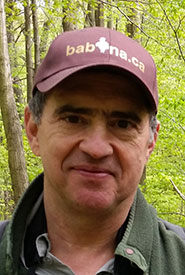What's so special about Kenauk?

Osprey nest on Lac Papineau in Kenauk, viewed by several participants in the 2016 survey (Photo by Richard Gregson)
Kenauk is big. Really big! In terms of surface area, it’s the largest conservation project ever undertaken by the Nature Conservancy of Canada (NCC) in Quebec, and certainly one of the largest in Canada. The site, located about eight kilometres north of Montebello, contains more than 60 lakes, many with breeding common loons. Yet it lies in close proximity to two cities: Montreal and Ottawa. This imperfect rectangle extends about 16 kilometres from west to east and about 21 kilometres from south to north. And it contains all of the birds you would expect to find in a natural area in this part of Canada.
Kenauk’s main attractions are its natural state, despite some logging that actually provides more habitats (for example, for Canada warblers), its large size, its proximity to two urban centres, the fact that you can stay comfortably in chalets there and the abundance of gravel roads without much traffic. Can you think of another such place?
NCC has developed a conservation plan for the property. Now NCC is improving its understanding of the animals, plants and habitats present on, and in the immediate vicinity of, Kenauk by conducting more detailed surveys ― and this is where my work with NCC and Bird Protection Quebec (BPQ) comes in.
In 2014, my long-time colleague, friend and former BPQ board member, Joël Bonin, who was then NCC’s conservation director in Quebec, asked me to start conducting bird surveys and create a bird species database for Kenauk. I had met and hired Joël in 1989 while I was setting up the Centre de données sur le patrimoine naturel du Québec, Canada’s first provincial Conservation Data Centre.
Surveying birds through the years

Trout for dinner for common loon, which Robert Alvo has studied since 1982 to determine the effects of lake acidification on its breeding success. (Photo by Richard Gregson)
In July 2014, I conducted two bird surveys in Kenauk: one of them alone, the second with two other volunteers. These surveys provided us with a sense of which species were breeding on this mammoth property, based on data collected during the fledgling period (the time in the breeding season when the young begin to fly). Then in 2015, I coordinated two more volunteer bird surveys, this time in June, during the nesting period when there is a nest being built, or it has eggs or young, and when we can listen for the adults, mostly the males, sing.
In 2016, I coordinated a bird survey in September to get a better sense of the birds that were present late in the breeding season (a period when we obtain a better indication of successful breeding for many species) and during the early southward migration. Survey data combined with observations from other birders allowed me to create the Kenauk bird checklist.
During the summer 2016 survey, we found 68 species, including two previously undocumented ones: wild turkey and merlin. Five species that we found close to Kenauk in 2015 were brown thrasher, sedge wren, bobolink, eastern meadowlark and brown-headed cowbird.
Nighttime data for Kenauk is lacking during the breeding season, early spring (April and early May), late autumn migration and winter, and for remote parts of the property that have difficult access. More extensive surveys around the perimeter of Kenauk might be useful, and would certainly add to any birder's trip list because of the presence of field habitats outside Kenauk, as Kenauk itself consists mostly of forest and lakes.
In 2017, we conducted two surveys in August and September. There are currently 144 species known to us on the Kenauk bird checklist, with the following status: 30 confirmed breeding, 19 probable breeding, 61 possible breeding, 33 migrants and one species found only in winter. Thirteen of these species are considered at risk, in the sense that they are listed under federal and/or provincial laws. We suspect that there are other species yet to be found, including some species at risk.
How bird surveys can inform conservation actions
The goal of the bird surveys is not only to obtain a list of the species present, but also to find out where they occur on the property, to determine the best possible evidence of breeding for each species and to know which species occur during the non-breeding seasons. All of this assists in making conservation decisions. Another goal is to search for the cerulean warbler, a nationally threatened species identified by a consultant in 2012 as having appropriate habitat at Kenauk. Any evidence of breeding would constitute a northward breeding range extension of this species. To date, we have received only unsubstantiated evidence of the presence of this species at Kenauk.
When conducting volunteer survey events, I always ask volunteers to keep their eyes open for any habitats on the property we have not found yet, especially fields (for sparrows and other field birds) and mud flats/sand flats (for shorebirds). To date, we have surveyed about 70 per cent of the property. The other 30 per cent is inaccessible by road, though some habitats may be accessed by cross-country skiing or snowshoeing. Lac Papineau is so big that we have surveyed only parts of it by motorboat.
I have been encouraging NCC to have more surveys done on other vertebrates and also invertebrates, especially some species at risk that I think may be found on Kenauk. Every summer, biologists, researchers, interns and volunteers search for potential species that may be present at Kenauk. For example, they look for insects and spiders in maple trees and amphibians in vernal pools. To learn more about current research projects, visit Kenauk Institute’s website.
An earlier version of this article was originally published in Bird Protection Quebec’s newsletter, The Song Sparrow, in February 2017, and is reposted with permission.


